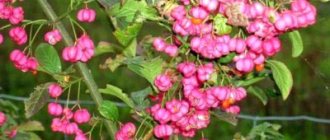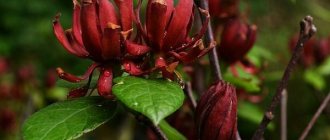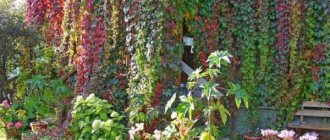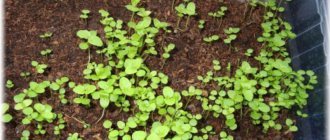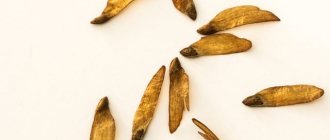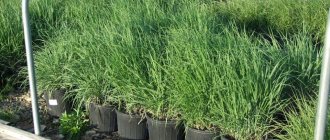Short description
Euonymus, in Latin Euonymus, translates as “good.” The Slavs also called the bush: night blindness, blind hen, wolf's bast, privet. The plant is poisonous. Most euonymuses are shrubs or small trees. Some of them are evergreen. They can form creeping shoots or climb, clinging to their roots, onto tree trunks, rocks, and walls.
- Form. Among the many species and varieties, euonymus is suitable for the garden, which will create a thick cover, decorate the landscape in the form of small shrubs, or grow into a majestic shrub.
- Dimensions. Depending on the variety, Euonymus grows 2-5 m in height, forming spreading crowns. Garden forms of creeping or climbing euonymus reach up to 10 m in height, when grown with appropriate supports.
- Leaves. The leaves are relatively small, round or longitudinally oval. All species that shed their leaves for the winter in the fall show intense leaf coloration ranging from orange to red. Evergreen euonymuses turn their leaves slightly pink or reddish in winter.
- Flowers. Greenish-yellow flowers develop in May, very small and inconspicuous.
- The fruits of the eonymus bush are presented in the form of tetrahedral bags and look very impressive. The seeds, surrounded by an orange capsule, emerge from a sac resembling the color and shape of a cardinal's hat. Hence the somewhat controversial German name "Pfaffenhütchen" (priest's hat).
Euonymus hamiltonianus Winter Glory
The plant has low resistance to aphids and other pests.
Euonymus: planting and care in open ground
Like any woody plant, euonymus can be planted in autumn and spring. But it is worth taking into account that different types of this shrub require certain care.
If you plant cuttings, it is advisable to do this in the fall so that by spring they have time to take root in the ground. Planting seeds requires preliminary stratification. This method should only be carried out in early spring.
How to choose seeds?
Gardening stores provide a wide range of euonymus seeds, but you need to choose based on where the future shrub will be planted.
If euonymus is already growing on the site and has seed pods, then the seeds are removed from them. Then they are treated with a manganese solution and sown in a moistened substrate.
In winter, you need to insulate the bed if the seeds were planted in the spring. Also, the land must be stratified. Pots with seeds should be placed in the refrigerator on the bottom shelf for 4-5 months.
Thanks to this technique, the seedlings will successfully sprout at the same time. When it gets warm, around April to May, the seedlings can be planted in the garden. In open ground, young euonymus will have to be grown for 3-4 years in order for buds to appear on them.
Landing area
Depending on the type of euonymus, the area for future planting is selected. Asian variegated varieties are best planted on the sunny side. Shade-tolerant varieties, such as Japanese and Dwarf, will feel better next to other trees that create shade.
The area for the plant should be large, since the shrub is prone to rapid growth. You should avoid planting in clay soil to avoid moisture stagnation. But, if there is no other option, you can dilute the soil with drainage.
Landing
To properly plant euonymus, holes should be dug in advance. This is necessary to prevent excessive penetration of seedlings into the ground when the soil settles. It is important to mix the soil with drainage.
It is advisable to fertilize with rotted manure with the addition of mineral fertilizers. Before sending the plant into the ground, it is advisable to dip it in a mixture of clay and potassium permanganate.
After planting, the soil around the seedling needs to be compacted. Then the soil is mulched and watered abundantly. All euonymuses love humus-rich, moist, slightly alkaline soil. If the soil is too acidic, it can be limed. Sand mixed with humus can dilute heavy clay soil.
Shrub care
It is recommended to regularly water only young bushes, and adult euonymus require additional watering only in times of drought. During the season, the number of waterings is reduced to 3-4.
The same number of times you need to loosen the soil around the euonymus trunk. To improve soil aeration, the soil needs to be regularly weeded and the mulch updated.
In the spring, you need to fertilize euonymus, since it is during this period that the shrubs are especially lacking in nutrients. It is advisable to fertilize with organic matter. To stimulate flowering, it is worth adding inorganic fertilizers to the soil. It is desirable that potassium, phosphorus and trace elements predominate in the composition.
In early spring, you need to trim off branches that spoil the appearance of the bush - this is easy to do even for a beginner.
To give the euonymus a cone shape, you will have to practice a lot, but the result is worth it - you get a beautiful landscape decoration.
Euonymus cuttings. How to propagate by cuttings. Video:
Shrub in landscape design
Tall varieties with beautiful leaf color and picturesque crown are ideal for individual plantings. Due to its relatively high shade, the euonymus plant can be planted under short tall trees.
Low and spreading varieties are suitable for autumn beds. Spectacular compositions are formed with ornamental grasses and tall flowering perennials.
Where is euonymus used?
Although the fruits of euonymus are poisonous, in folk medicine it is used in the form of decoctions. This medicine must be used with great caution, especially since official medicine does not prescribe drugs based on it.
As for wood, gutta-percha was made from the warty euonymus. In addition, it is used for a variety of crafts.
Nowadays, the use of euonymus in garden design is more developed. Beautiful hedges grow from it, and arbors are entwined in the form of vines.
Choosing a place in the garden
- Illumination. Eonymus loves the sun. Especially varieties with multi-colored leaves require sunlight for proper flower development. Their monochromatic relatives grow well in partial shade.
- The soil. Euonymus grows well in any soil. The shrub receives optimal conditions on fertile soil, rich in humus and nutrients, from a loose to sandy-clay structure. The main thing is that the bush does not have to deal with stagnant water or compacted soil.
Basic conditions:
- Location – sunlit, partial shade.
- A warm place, protected, without cold drafts.
- Fresh, moist, moderately dry soil.
- Lots of humus, good soil permeability.
Medicinal properties of euonymus
Before being treated with euonymus, you should clearly remember that the plant is poisonous; you cannot simply make a decoction or tincture - this is dangerous to health and life. You should consult a doctor or experienced herbalist. The pharmaceutical industry does not use euonymus for the manufacture of medicines, but the folk industry uses it carefully and in small doses.
All parts of the plant are medicinal:
- wood contains pectin, glucose, sucrose, tannins, organic acids, vitamin C, steroids;
- the bark is rich in anthraglycosides, which have laxative properties, fatty acids, and carbohydrates;
- the leaves contain vitamin C, alkaloids, flavonoids;
- seeds contain carbohydrates, fatty oils and acids, vitamin C.
Water and alcohol infusions and decoctions of euonymus are taken orally and applied as lotions for a number of diseases:
- nervous disorders;
- severe headaches;
- constipation;
- hypertension;
- hepatitis;
- vomiting;
- decreased potency;
- from parasites and worms.
Important! Since the plant is poisonous, you cannot create recipes on your own and use them without consulting an experienced herbalist.
Trimming
The plant prunes well and has become a very popular garden shrub in recent years. If some side shoots disturb the harmonious shape of the bush, they can be pruned during the growing season. Autumn or early spring are suitable for formative and sanitary pruning. Pruning allows the shrub to be thoroughly lit, providing light and air to the entire plant.
Breeding Basics
Poultry farmer - planting and care in open ground
Euonymus reproduces well in several ways. First of all, these are seeds. Specialized agricultural stores offer a wide range of planting material for this crop. Many people buy them for the first time, and then collect them from their own bushes after the seed pods have ripened.
After collecting and removing the shell, they are treated with a weak solution of potassium permanganate and placed in the ground. If spring sowing is planned, the seeds are additionally stratified and placed in a moist substrate. In this form, it is convenient to store future seedlings in the refrigerator for up to five months. Such tactics bring results - friendly shoots and strong seedlings. They are planted after the frost has subsided according to the scheme given above.
Cuttings
The bush can also be propagated by cuttings. Specimens no older than 5 years are suitable for this. Future cuttings are harvested in June-July with a maximum length of up to 8 cm. The lower edges of the cut are treated with root and gamair, and then placed in closed fertile soil, mulched with grass. Next, sprinkle with sand in a layer of up to 4 cm and leave it alone for one and a half to two months. After this, they are planted in a permanent place.
Cuttings
You need to prepare for planting cuttings. The process takes 2 years. In the first year in the spring, the bed is worked well with a shovel and spilled with a solution of boric acid according to the instructions. Then it needs to be covered with black plastic film until the weeds emerge. The procedure is repeated up to 4 times per season.
The next year in the spring, the bed is dug up again, adding 50% thiodan or 5-7% karbofos and spilled with a 10% solution of boric acid, prepared according to the instructions on the package.
For your information! Before planting the cuttings, the ground is covered with black film. Immediately before planting, the soil is loosened and isolated weeds are removed.
Root suckers
Immediately after the snow melts, Japanese euonymus can be propagated by root suckers. The recommended length for this procedure is 20-30 cm. This is the most simple, but pedantic scheme. The plant must be carefully dug up along with the lump and transferred to a prepared hole or container.
Propagation of euonymus by cuttings and seeds
Since the bush usually grows in a semicircle, it gives the gardener an easy way to produce new seedlings - the usual rooting of layering or cuttings. Propagation by cuttings occurs as follows: a semi-lignified shoot is bent towards the ground, placed in a prepared groove and covered with earth. You can secure the shoot in the ground with a metal hook.
Advice! A small cut in the bark stimulates the impulse for root formation.
After a few months, when the roots have grown sufficiently, you can cut the finished seedling from the mother plant.
Euonymus can be propagated by seeds. When using the sowing method, it should be remembered that the seeds do not directly inherit the characteristics of the parent plant.
Signs and superstitions
People believe that an euonymus growing near a house protects its owners from troubles and misfortunes, and its fruits are recommended to be kept as a strong talisman.
Euonymus - protective talisman
The warty euonymus, despite its not very pleasant aroma, which attracts all the flies in the area, is a pleasant-looking plant, a rich bush with a lush crown. It will decorate a garden or summer cottage, becoming a bright accent in landscape design.
Euonymus is a poisonous plant!
Unfortunately, this beautiful plant has a dark side. All its parts, and especially the fruits, contain highly toxic glycosides. A small amount of fruit consumed orally causes:
- weakness;
- vomiting;
- diarrhea.
Attention! Consumption of about 30 berries is considered a lethal dose for an adult, causing cardiac dysfunction, paralysis and death.
For this reason, Euonymus is not suitable for a summer house where small children live. Poisoning threatens domestic animals – large and small.
What you need to know about euonymus
For landscaping, cultivated plant forms, dwarf varieties and shrubs are used. Where it is cold in winter, single plants are grown in pots and tubs, putting them in a cool place for the winter.
In nature, euonymus grows under the canopy of trees. In bright sunny colors, the decorative effect of the leaves is lost. The best temperature for the plant is 18-22 degrees. The warmer it is, the more often you need to moisten the leaves and the lump of earth. If the euonymus winters outdoors, its branches need protection. It is best to make a bush coat from spruce branches of coniferous trees.
The plant is poisonous. Just 35 berries for an adult is a lethal dose. It should not be planted in a place accessible to children.
Types and varieties
Fortune's euonymus (Euonymus fortunei)
The evergreen shrub Euonymus fortunea grows 30-60 cm high, low or creeping. In nature, the Fortune species is not demanding; it grows in wet or swampy areas on the banks of streams. The plant can climb roots and stones to a height of up to 1.5 m. On hot days it requires a lot of water. In the Fortune culture, fertile, humus soil is better suited.
Varieties and varieties of Fortune:
- Coloratus is a fast-growing variety with large evergreen leaves. Resistant to diseases, pests, frost-resistant.
- Emerald Gaiety - this variety has small dark green leaves with a white edge. Forms a dense bush or carpet. Non-frost resistant.
- Emerald Gold is a bushy shrub with small, light green leaves edged with bright yellow. Non-frost resistant.
- Interbolwi - small yellow leaves with a dark border. Resistant to frost.
- Silver Queen - Large white-green leaves. The bush grows quickly. May freeze in winter.
- Sunspot - small leaves with a yellow center. Creates a green-yellow carpet. Frost-resistant.
Winged Euonymus (Euonymus alatus)
The bush rises to a height of 200-300 cm, forming an irregularly shaped bush. Grows well in sunny or slightly shaded areas. In summer it requires abundant watering. The leaf turns beautifully into strong shades of red.
European euonymus (Euonymus europaeus)
Shrub 150-600 cm high. In autumn the leaves become intensely red. Decorative fruits appear from inconspicuous flowers, hanging on the bushes. It can grow in partial shade, but then the leaves and seed sacs do not show as much color.
Flat petiolate (Euonymus planipes)
Grows up to 200 cm in height. In autumn the large leaves turn red. The flowers are inconspicuous, the fruits are interesting: red-pink bags on long stems and seeds in red “gloves”. Grows in all garden soils.
Warty (Euonymus verrucosa)
Rarely found, grows up to 250 cm in height, sparse shrub. The branches are covered with brown warts - hence the name. Black seeds hang from a red sac surrounded by a red shell.
Japanese (Euonymus japonicus)
A creeping evergreen shrub recommended for gardens with poor soil. Loves semi-shaded, even shady positions. It rises up to 400 cm in height, climbing walls and gazebos.
Features of caring for Euonymus at home
Euonymus is a relatively unpretentious plant that does not require complex care.
Watering and spraying
Aloe tree - what is it, description of the plant
Watering is moderate, done as the soil dries completely.
The humidity level is not particularly important for the plant. You only need to spray the bush if it is a houseplant. The procedure is performed during the intense summer heat. Additional moisture of the leaves helps prevent plant diseases.
Attention! Use only boiled or filtered water, otherwise plaque will remain on the leaves. In the summer, a bush in a pot can be watered from the shower with warm water, but then the ground must be covered with polyethylene.
Priming
Euonymus likes soil that is neutral to slightly acidic. If the soil is acidic, you need to add lime. The soil should be loose and light to provide aeration for the roots.
The recommended soil composition for a home bush in a pot is garden soil, peat compost, sand and lime or ash, with the addition of a small amount of complex fertilizers.
Euonymus flowers are small and inconspicuous
Feeding
Feeding is done 2 times a year. Complex inorganic fertilizers are used.
